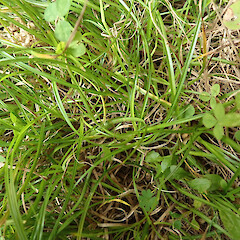Carex inopinata
Common name
grassy mat sedge
Synonyms
None
Family
Cyperaceae
Flora category
Vascular – Native
Endemic taxon
Yes
Endemic genus
No
Endemic family
No
Structural class
Sedges
NVS code
The National Vegetation Survey (NVS) Databank is a physical archive and electronic databank containing records of over 94,000 vegetation survey plots - including data from over 19,000 permanent plots. NVS maintains a standard set of species code abbreviations that correspond to standard scientific plant names from the Ngä Tipu o Aotearoa - New Zealand Plants database.
CARINO
Chromosome number
2n = c.60
Current conservation status
The conservation status of all known New Zealand vascular plant taxa at the rank of species and below were reassessed in 2017 using the New Zealand Threat Classification System (NZTCS) – more information about this can be found on the NZTCS website. This report includes a statistical summary and brief notes on changes since 2012 and replaces all previous NZTCS lists for vascular plants.
Please note, threat classifications are often suggested by authors when publications fall between NZTCS assessment periods – an interim threat classification status has not been assessed by the NZTCS panel.
- Conservation status of New Zealand indigenous vascular plants, 2017 . 2018. Peter J. de Lange, Jeremy R. Rolfe, John W. Barkla, Shannel P. Courtney, Paul D. Champion, Leon R. Perrie, Sarah M. Beadel, Kerry A. Ford, Ilse Breitwieser, Ines Schönberger, Rowan Hindmarsh-Walls, Peter B. Heenan and Kate Ladley. Department of Conservation. Source: NZTCS and licensed by DOC for reuse under the Creative Commons Attribution 4.0 International licence.
2017 | Threatened – Nationally Vulnerable | Qualifiers: DP, Sp
Previous conservation statuses
2012 | Threatened – Nationally Vulnerable | Qualifiers: Sp
2009 | Threatened – Nationally Endangered | Qualifiers: DP, CD, Sp
2004 | Threatened – Nationally Endangered
Distribution
Endemic. Eastern South Island from the upper Awatere River to Deep Creek and Tapanui, Southland.
Habitat
Carex inopinata has been found in several different habitats, unified by their high fertility. These include riparian alluvial terraces under rohutu (Lophomyrtus obcordata (Raoul) Burret) forest, limestone and schist overhangs, and at a forest margin on a rubbly slope under shrubland. Occasional plants have been found at the base of limestone and schist rocks.
Detailed description
Rhizomatous, widely creeping sedge forming diffuse mats. Rhizomes 0.5–0.8 mm diameter, bearing widely spaced, tufted, leafy culms up to 10 mm long; basal culm sheaths dull brown. Leaves grass-like, > culms up to 100 × 1 mm, dark green, channelled, margins distinctly scabrid toward apex. Inflorescence of 2–3 pedunculate spikes; terminal spike male, slender; 1–2 lower spikes female, 5–7-flowered; bracts subtending inflorescence, numerous, leaf-like. Glumes more or less equal to or just < utricles, ovate-lanceolate, papery membranous, often streaked with red, midrib extending into ascabrid awn. Utricle 6–7 mm, biconvex, ovate-lanceolate, basally light brown, grading to dark red-brown towards apex, nerves distinct, these light brown; beak very narrow, 3 mm long, deeply bifid, crura spreading, margins and orifice scabrid. Stigmas 3. Nut 2 mm, trigonous with distinctive rounded angles, oblong, grey-brown to brown.
Similar taxa
Carex breviculmis and some hook sedge species are similar. From these Carex inopinata can be recognised by the presence of fine teeth on the upper leaf margins only near the tip and by the few large, non-hook bearing, red-brown utricles. C. breviculmis leaves are also wider and finely toothed for their entire length, and its spikelets are evenly spaced up the stem, while the utricles smaller. Sterile specimens of hook sedge species can be dsitinguished from C. inopinata by their leaves which are finely toothed for their entire length.
Flowering
October–January
Fruiting
November–February
Life cycle
Nuts surrounded by inflated utricles are dispersed by granivory and wind (Thorsen et al., 2009).
Propagation technique
Easy from rooted pieces and fresh seed. An unusual plant that makes an attractive ground cover for a semi-shaded site. This species does best in a well drained, moderately fertile soil. Although it rarely flowers and fruits, some clones in cultivation do so frequently. Carex inopinata is very drought tolerant.
Threats
The diminutive stature and open, diffuse mat-forming habit increase this species vulnerability to introduced weeds. This species is intolerant of much competition from other taller or faster growing plants which is possibly why it favours semi-shaded situations. Some populations are threatened through recreational activities such as rock climbing.
Etymology
carex: Latin name for a species of sedge, now applied to the whole group.
Attribution
Fact Sheet prepared by P.J. de Lange (31 August 2006): Description adapted from Moore and Edgar (1970) - see also de Lange et al. (2010).
References and further reading
de Lange PJ, Heenan PB, Norton DA, Rolfe JR, Sawyer JWD. 2010. Threatened Plants of New Zealand. Canterbury University Press, Christchurch. 471 p.
Moore LB, Edgar E. 1970. Flora of New Zealand, Volume II. Indigenous Tracheophyta: Monocotyledones except Gramineae. Government Printer, Wellington, NZ. 354 p.
Thorsen MJ, Dickinson KJM, Seddon PJ. 2009. Seed dispersal systems in the New Zealand flora. Perspectives in Plant Ecology, Evolution and Systematics 11: 285–309.
NZPCN Fact Sheet citation
Please cite as: de Lange, P.J. (Year at time of access): Carex inopinata Fact Sheet (content continuously updated). New Zealand Plant Conservation Network. https://www.nzpcn.org.nz/flora/species/carex-inopinata/ (Date website was queried)











